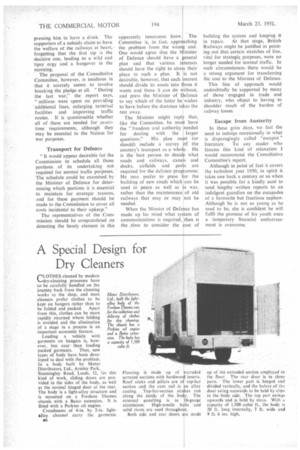A Special Design for Dry Cleaners
Page 40

If you've noticed an error in this article please click here to report it so we can fix it.
rLOTHES cleaned by modern N-•dry-cleaning processes have tobe carefully handled on the journey back from the cleaning works to the shop, and most cleaners prefer clothes to be kept on hangers rather than to be folded and packed. Apart from this, clothes can be more rapidly returned where folding is avoided and the elimination of a stage in a process is an important economic feature.
Loading a vehicle with garments on hangers is, however, less easy than loading packed garments. Thus, new types of body have been developed to deal with the problem. In a body built by Motor Distributors, Ltd., Armley Park, Stanningley Road, Leeds, 12, for this kind of work, sliding doors are provided in the sides of the body, as well as the normal hinged door at the rear. The body is a light-alloy structure and is mounted on a Fordson Thames chassis with a Baico extension, It is fitted with a Perkins oil engine.
Crossbeams of 4-in. by 2-in, lightalloy channel carry the garments. 16 Flooring is made up of xtruded serrated sections with hardwoo inserts. Roof sticks and pillars are a top-hat section and the cant rail is an alloy casting. .Top-hat-section str es run along the inside of the bo y. The external panelling is in 16-gauge
aluminium. High-tensile b Its 'and solid rivets are used through° t.
Both side and rear doors re made
up of the extruded section employed in the floor.. The rear door is in three parts. Thelower part is hinged and divided vertically, and the halves of the door swing outwards to be held by clip,; in the body side. The top part swings upwards and is held by stays. With a capacity of 1.500 cubic ft., the body is 20 ft. long internally, 7 ft. wide and 9 ft. 6 ins. high.




















































































